 THE GATEHOUSE
THE GATEHOUSE
In the world of dieselpunk, where the Depression never arrived, World War II may still be fought as a prolonged cold war, with the German Reich as a global power stretching from the shores of Western Europe to the plains of Russia to the torrid desert of North Africa. Under the pressure of the ongoing war effort, German science is typically depicted as having continued its experimenting with biotechnologies, sparking off a genetic revolution of bio-mods, clones and organ harvesting.
In Germany itself, eugenics and selective breeding may be widespread with the purpose of improving the species. In the pre-war era, Nazi eugenics strived to remove those with congenital defects from the gene pool, with varying degrees of resistance from the population. Those deemed to possess superior genes—which often equated to those with noble blood or of wealth and influence—were encouraged to have as many children as possible. Criminals and degenerates might be sterilised to prevent their bad genes from being passed on to the next generation. Euthanasia was widely practised. In a world where the Nazi regime never came to an end, this revolution of eugenics may well have produced a society obsessed with pure blood and the concept of the Übermensch; a philosophy of divine purpose and experience, according to Philip K. Dick in his The Man in the High Castle (1962), an alternate history novel in which the Axis rules supreme. “They’re not idealists,” writes Dick, “they’re cynics with utter faith.”
“Their view; it is cosmic. Not of a man here, a child there but an abstraction: race, land. Volk. Land. Ehre. Not of honorable men but of Ehre itself, honor; the abstract is real, the actual is invisible to them. Die Güte, but not good men, this good man. It is their sense of space and time. They see through the here, the now, into the vast, black deep beyond, the unchanging. And that is fatal to life. Because eventually there will be no life ... It is all temporary ... They want to aid nature ... They identify with God’s power, and believe they are godlike. That is their basic madness. They are overcome by some archetype; their egos have expanded psychotically so that they cannot tell where they begin and the godhead leaves off. It is not hubris, not pride; it is inflation of the ego to its ultimate—confusion between him who worships and that which is worshiped. Man has not eaten God; God has eaten man.”
Herman Rausching has Hitler say in his Gespräche mit Hitler (1939): “Those who see in our National Socialism little more than a political movement know scarcely anything of it. It is more even than a religion—it is the Will to create mankind anew.” Destiny and divine ambition determined the Nazi spirit. Dieselpunk exaggerates, perhaps even fetishizes, yet very often ridicules the Nazis’ obsession with esoterica and the occult.
Inspired by historical missions of the Ahnenerbe to Antarctica and Tibet and investigations into the origins of the Aryan species, we find Nazis seeking the Ark of the Covenant in Raiders of the Lost Ark (1981), the Holy Grail in Indiana Jones and the Last Crusade (1989), and monstrous entities to turn the tide of war in their favor in Mike Mignola’s Hellboy. All endeavours fail miserably of course and wreck nothing but havoc upon the Nazis themselves. As evident from some of the depictions below, sometimes Imperial Germany can be a swell breeding ground for things occult too!
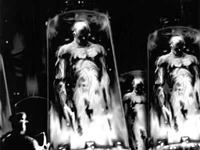
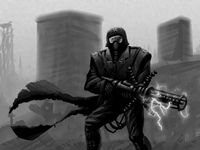
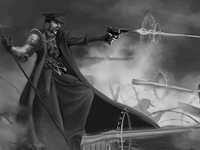
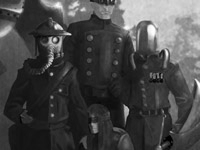
Artwork by Yannis Bolman, Eric Kozlowsky. Click to hide this item.
Many of the extraordinary and sometimes bizarre technologies employed by Nazi-Germany in dieselpunk fiction are based upon historical developments and breakthroughs. As the war drew near, advanced aircraft, as the Messerschmitt Me 262, the world’s first operational turbojet fighter, as well as Vergeltungswaffen and, some say, a proto-nuclear weapon, were rushed into production while Germany’s wartime rocketry program paved the way for the post-war conquest of space. Had the war not ended, it is not entirely unimaginable that many of these projects came to full fruition. Or, in the words of TV Tropes, “if you have to pick one WWII power to give antigravity and a moonbase to, the choice is obvious.”
Dieselpunk video games enthusiastically embrace the experimental and sometimes ridiculous weapons of war developed in Nazi-Germany as the Second World War neared its conclusion. Because of these technologies, Germany is able to prolong the war effort in the alternate histories of games as Dream Pod 9’s Gear Krieg, Ubisoft's Blazing Angels II (2007) and Digital Reality’s War Front: Turning Point (2007).
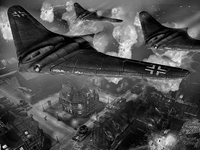


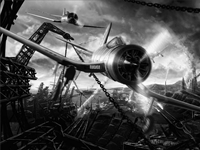
One of the most fascinating alternate histories of World War II comes from a Bulgarian engineer named Vladimir Terziski who bills himself as president of an “American Academy of Dissident Sciences.” Terziski claims that with their advanced rocket technology, the Nazis actually landed on the Moon! He writes that the Moon has an atmosphere that makes vegetation possible and requires no spacesuit to be worn. Thus the 1969 moon landing was staged to prevent the rest of the world from learning about the conspiracy and of course the author shreds not from incorporating the Kennedy assassination in his great revelation. What Terziski does neglect to explain though is why the Space-Nazis, with all their secret advanced technology and weaponry, still lost the war.
“The Germans landed on the Moon as early as probably 1942, utilizing their larger exoatmospheric rocket saucers of the Miethe and Schriever type. The Miethe rocket craft was built in diameters of 15 and 50 meters, and the Schriever Walter turbine powered craft was designed as an interplanetary exploration vehicle. It had a diameter of 60 meters, had 10 stories of crew compartments, and stood 45 meters high.
“Ever since their first day of landing on the Moon, the Germans started boring and tunneling under the surface, and by the end of the war there was a small Nazi research base on the Moon. The free energy tachyon drive craft of the Haunibu-1 and 2 type were used after 1944 to haul people, materiel and the first robots to the construction site on the Moon. When Russians and Americans secretly landed jointly on the Moon in the early fifties with their own saucers, they spent their first night there as guests of the ... Nazi underground base. In the sixties a massive Russian-American base had been built on the Moon, that now has a population of 40,000 people, as the rumor goes. [...] the Germans continued their space effort from their south polar colony of Neu Schwabenland.”
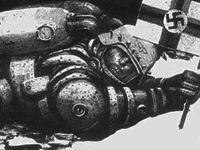
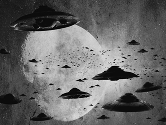
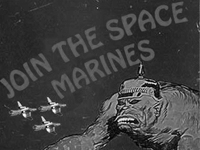
Artwork by Iron Sky, Przemyslaw Truscinski, Jessy Veilleux, Vlado. Click to hide this item.
THE SEARCH FOR THE SUPERSOLDIER
During the war, German scientists synthesized anabolic steriods and experimented on concentration camp inmates and prisoners of war in an attempt to threat chronic wasting. Experiments were allegedly conducted on German soldiers to increase their aggression and agility, however there is no evidence whatsoever that a full-fledged Übersoldier project was ever considered. Yet we find “supersoldiers” popping up in scores of video games.
Perhaps the first video game to explore a combination of Nazi occult and genetic engineering was Activision’s Return to Castle Wolfenstein (2001). The player takes on the role of an Allied elite soldier sent to investigate rumors surrounding the Paranormal Division of Heinrich Himmler’s SS. Captured and imprisoned in the Castle Wolfenstein, the player must “battle the most horrific creatures ever unleashed” while seeking to escape, facing “zombies brought back from the dead through dark magic and [...] mutants created through twisted science.” The ultimate product of this clandestine confunction between occult activity and genetic engineering is depicted in the game to be an Übersoldier, half-man, half-machine, frightening yet strangely fascinating as a glimpse of what might have been.
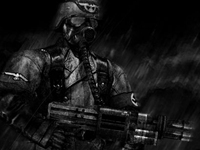
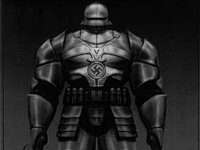
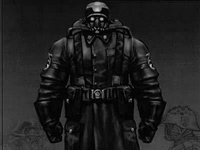
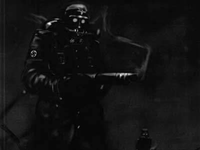
The supersoldiers depicted in Return to Castle Wolfenstein and other games as ÜberSoldier (2006) are brutish cyborgs augmented either through eugenics and genetic engineering or cybernetic implants and technological enhancements. They are typically equipped with the most dreadful of weapons, as Tesla guns and Panzerfäuste, making them the ultimate foes of World War II simulations.
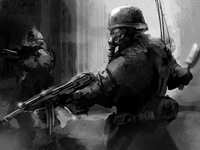
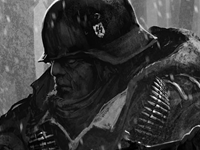
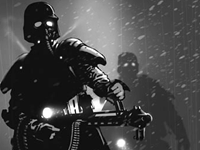
Artwork by Tomasz M. Jedruszek. Click to hide this item.
